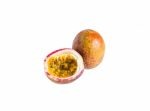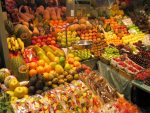
One of the leading issues in the supply chain for tropical fruits and vegetables is chilling injury. It occurs to produce when they are deliberately cooled down for transport and storage. Soft fruit is particular is especially vulnerable.
Chilling injury only occurs when produce is cooled to below 12ºC but above the freezing point. It is distinct from freezing. In chilling injuries, the fruit and vegetable cells are damaged especially the plasma membrane and this leads to cell leakage and disruption of metabolism. Alterations in membrane permeability lead to loss in cell turgor and the produce loses firmness and discolours through uncontrolled enzymatic activity.
The symptoms of chilling injury are often mirrored in other stress related conditions such as drought, root rot, chemical damage, and light and heat stress.
The Supply Chain And Post-Harvesting
Ideally, a grower of any fresh produce wants to harvest their product at its optimum maturity or at a time when it reaches the consumer as this optimum. The supply chain for this type of produce is much more complex than we might believe. The commercial situation is that the consumer will purchase fresh produce when they consider it to be ripe or in a state of ripeness that is suited to their needs. It means marrying the picking, packing, storage and distribution activities in accordance with this important delivery principle.
What must not be forgotten is that any fresh produce is still alive after picking. It will undergo compositional changes because it is respiring. The changes taking place are:
- loss of water through diffusion, evaporation and respiration
- changes to nutrients, usually detrimentally
- loss of vitamins and antioxidants
- a conversion of starch to sugar and often back to starch
Generally, the higher the level of respiration the shorter the shelf-life. Hence, the need for low temperature storage.
Low Temperature Storage
One of the most common methods for moving fresh produce such as vegetables and fruit around the world is low temperature storage. In most cases it is a convenient postharvest method. It allows for the preservation of fruit and vegetables with minimal changes to quality. Movement of produce by sea is the cheapest and most convenient method because enormous quantities of material can be transported. Unfortunately, it is not a rapid transport method and under normal ambient conditions, any fresh produce transported this way loses its quality before it reaches the consumer. Chilling is a suitable method for many types of fresh product unfortunately some however is susceptible to damage using this process. Supply chain managers and researchers have been identifying other means for preservation of fresh produce.
The fruits and vegetables most susceptible to chilling injury are:
- avocado
- banana
- cherimoya
- citrus
- cucumber
- eggplant/aubergine
- feijoa
- guava
- jujube
- mango
- okra
- olive
- papaya
- passion fruit
- pepper including chilis
- pineapple
- plantain
- pomegranate
- sapote
- sweet potato
- tomato
Most focus has been on tropical fruit which are especially susceptible to chilling injury. Mango, papaya and bananas appear to suffer extremely widely from any form of chilling and these are often focused on.
Mango (Mangifera indica L.)
Mango especially, is well known for is susceptibility to chill injury. Most suppliers can only deliver the fruit if it is stored above 12ºC (Yadav et al., 2014). Any higher and the benefits of low temperature in suspending respiration in particular start to diminish.
When the temperature of storage drops below 10ºC mangoes exhibit all the classic symptoms associated with chill injury.
In mango, the fruit generally ripens unevenly and in some cases does not at all. The surface usually shows pitting and discolouration; browning is the most common effect and pervades into the flesh. As the injury progresses, necrotic areas develop with wateriness in some parts. Decay rapidly progresses.
The susceptibility of mango in particular varies with the level of maturity of the fruit, the cultivar, the length of time of exposure to various chilling temperatures (Chhatpar et al., 1971; Mohammad & Brecht, 2002). These aspects apply to other fruit as well by the way.
The symptoms of chilling injury appear at various phases of chill storage, some almost immediately on storage but most appearing after several days of exposure when brought back to room temperature.
In mangoes as in other fruits, there is a breakdown in carotenoids, the sensory properties severely decline with loss of aroma and flavour. With this is bruising as well as loss of flesh texture (Cantre et al., 2017)
Yadav et al., (2014) have considered gamma radiation processing of 0.40 kGy as a way to not only preserve mango physiology but also allow for storage at 9°C but again not that much lower.
Peppers
Peppers are prone to damage from chilling. They are probably less susceptible to chilling injury as mangoes. It seems that storage below 7ºC certainly produces changes to respiration rates such that the pepper decays. Back in 1962, Lacy & McColloch assessed chill injury losses in bell peppers. They were observing sheet pitting in fruit stored at 32ºF (0ºC) but this was not seen at 40ºF (4.4ºC). Further changes were assessed in a variety of bell peppers in Japan (Kozukue & Ogata, 1972). Bell peppers are more prone to this than chili peppers (FoodWrite Ltd, 2016 unpublished research).
Seeds are prone to chilling injury and this is typical for peppers. The main browning material is chlorogenic acid (Kozukue & Ogata, 1972).
Rapid Analysis Of Fruit To Check For Chilling Injury
Multispectral imaging, which is a relatively modern development of computer analysis is a method that captures image data at specific frequencies across the electromagnetic spectrum. It has the benefit of being non destructive with no need to pretreat the produce.
On study has used multispectral imaging to classify apples which are bruised versus unbruised fruit. The accuracy is a creditable 91.5% (Huang et al., 2015).
References
, , , , , & (2017). Tissue breakdown of mango (Mangifera indica L. cv. Carabao) due to chilling injury. Postharvest Biology and Technology, 125, pp. 99–111. (Article)
, , & (1971). Biochemical studies on chilling injury in mangoes. Phytochemistry, 971(10), pp. 1007–1009 (Article).
, , , & (2015). Development of a multispectral imaging system for online detection of bruises on apples. Journal of Food Engineering, 146, pp. 62–71 (Article).
Lacy, P. and McColloch, L.P. (1962). Chilling injury and Alternaria rot of Bell peppers. USDA Mktg. Res. Rpt. 536.
, & (2002). Reduction of chilling injury in ‘Tommy Atkins’ mangoes during ripening. Scientia Horticulturae, 95, pp. 297–308 (Article).
, , , & (2014). Optimization of irradiation and storage temperature for maintaining physiological changes, marketable fruits, and sensory acceptance of alphonso mango (Mangifera indica). Agricultural Research, 3(4), pp. 360–369 (Article).


Leave a Reply